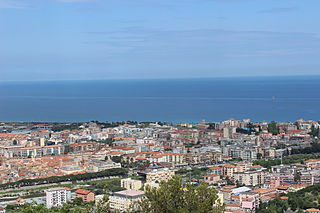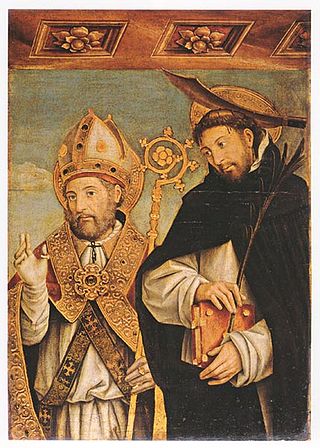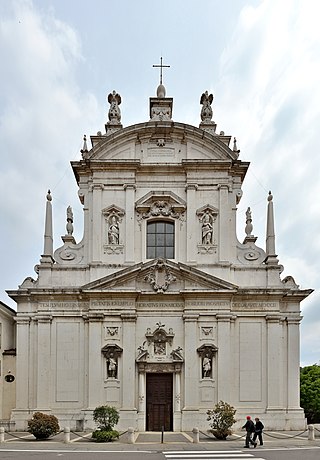Notes
- ↑ Catholic Online
- 1 2 3 4 5 6 Emanuele Borserini (April 30, 2009). "San Calogero di Brescia". Santi e beati. Retrieved April 11, 2011.
- ↑ Odden, Per Einar. "Den hellige Calocerus av Brescia (d. ca 121?)", Den katolske kirke
Saint Calocerus | |
|---|---|
| Martyr | |
| Died | 130 Albenga, Italy |
| Venerated in | Roman Catholic Church, Eastern Orthodox Church |
| Canonized | Pre-congregation |
| Major shrine | cathedral of Albenga |
| Feast | 18 April (Roman Catholic Church); 19 May (Eastern Orthodox) |
| Attributes | depicted as a Roman soldier |
Saint Calocerus (Italian : Caio, Calocero, Calogero) was a 2nd-century Christian martyr. His alleged "acts", belong to a much later period.
He was probably an officer in the Roman army under the Roman emperor Hadrian and was stationed in Brescia in Lombardy, Italy. [1] His life and legend are associated with Saints Faustinus and Jovita, and according to tradition, all three saints were soldiers from Brescia. [2] The constancy of Faustinus and Jovita led to the conversion of Calocerus, who in turn converted Secundus of Asti. [3]
According to tradition, Calocerus preached at Albenga and was martyred in this town. [2]
A local cult devoted to Calocerus was limited to the dioceses of Brescia, Milan, Asti, Ivrea and Tortona. [2] The cathedral of Albenga, built in the fourth and fifth centuries, was dedicated to him. [2] The alleged tomb of Saint Calocerus is conserved in the Civic Museum at Albenga. [2] The cathedral of Albenga contains an urn with some of his relics. [2]

April 17 - Eastern Orthodox liturgical calendar - April 19

Albenga is a city and comune situated on the Gulf of Genoa on the Italian Riviera in the Province of Savona in Liguria, northern Italy.
Saint Faustinus may refer to:

February 14 - Eastern Orthodox liturgical calendar - February 16

February 15 - Eastern Orthodox liturgical calendar - February 17

Jovita and Faustinus were said to be Christian martyrs under Hadrian. Their traditional date of death is 120. They are patron saints of Brescia. Faustinus is the patron saint of Pietradefusi.
Faustinus was bishop of Brescia from c. 360, succeeding Ursicinus. His feast day in the Roman Catholic Church is 15 February: 16 February in the Orthodox Church.

The Diocese of Brescia is a Latin diocese of the Catholic Church in the ecclesiastical province of the Metropolitan Archdiocese of Milan, in Lombardy.

Secundus of Asti is venerated as a martyr and saint. His feast day is generally celebrated on March 29. Until the 15th century it was celebrated at Asti on March 30, but it is now celebrated there on the first Tuesday in May. He was a historical figure who was beheaded at Asti under Hadrian. He is said to have been a patrician of Asti and a subaltern officer in the imperial army. It is known that a church was dedicated to him in the area as early as the 9th century.

Marcian of Tortona is a saint of Roman Catholic church. He is traditionally said to have been the first bishop of Tortona, in what is now north-western Italy, a post he held for forty-five years.

Evasius is believed to have been a missionary and bishop of Asti, in north-west Italy. He was forced to flee to the great Padan forest known as the Selva Cornea, where he and numerous followers were beheaded by pagan, or alternatively by Arian enemies, in the area of what is now Casale Monferrato. He is venerated as a saint of the Roman Catholic Church and is the patron of a number of towns in Piedmont and Lombardy. His cult is liveliest at Casale, where his remains are conserved in the cathedral dedicated to him.

Calimerius was an early bishop of Milan. He is honoured as a Saint in the Catholic and Eastern Orthodox churches and his feast day is on July 31.

The Diocese of Albenga–Imperia is a Latin diocese of the Catholic Church in Liguria, northern Italy; the traditional name of the Diocese of Albenga was changed by decree of the Congregation of Bishops in the Roman Curia, with the approval of Pope Paul VI, on 1 December 1973. It is a suffragan of the Archdiocese of Genoa.
Astius is a 2nd-century Christian martyr venerated by the Roman Catholic and Eastern Orthodox churches. He was the bishop of Dyrrhachium.
Santi Faustino e Giovita may refer to:

Eleutherius, also written as Eleutherus, Eleuterus and Eleftherios; sometimes called Liberalis or Liberator Greek: Ἐλευθέριος) and his mother Antia, or Anthia are venerated as Christian saints and martyrs in Greece and Italy.

The church of Saints Faustinus and Jovita, also known as the church of San Faustino Maggiore, is a church in Brescia, located on the street of the same name, Via San Faustino, along the last stretch to the north. It is the patron church of the city of Brescia and, for this reason, it is the most important religious building in the city after the cathedrals, the Old Cathedral and the New Cathedral.
Calogero is common given name and family name, and a place name of Greek origin.

Asti Cathedral, the episcopal seat of the Diocese of Asti, is a Roman Catholic cathedral in Asti, Piedmont, Italy. It is dedicated to the Assumption of the Blessed Virgin Mary and to Saint Gotthard, and at 82m long and 24m in height and width, is one of the largest churches in Piedmont, the highest expression of Gothic architecture of the region, and among the best examples of Lombard Romanesque appreciable in northern Italy.

The Treasure of the Holy Crosses is a group of items of high historical, artistic and religious interest kept in the Old Cathedral of Brescia in the Chapel of the Holy Crosses in the north transept. The treasure, usually locked inside a safe except during brief exhibitions, consists of: